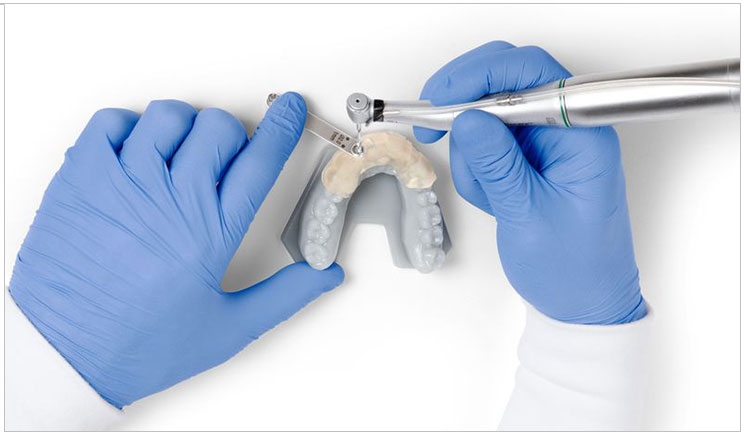
3-D printing has brought many benefits to dentistry—especially in implant surgery, where the growing use of customized surgical guides takes away the guesswork and helps dentists place an implant into a patient’s gum with a high degree of precision and safety.
But creating a surgical guide made to measure for an individual patient is typically a time-consuming and expensive task, putting it out of the reach of most dental practices.
To create a surgical guide, dentists either take a physical impression of the teeth, or they scan them digitally. Either way, the usual next step is to turn the fabrication process over to a dental lab. Each produced guide generally takes weeks to produce and could cost $250 to $750 depending on the laboratory and the complexity of the implant.
Of course, if a dental practice has its own 3-D printer—usually costing upwards of $50,000—it could print its own surgical guides. Outsourcing to an outside dental lab and the high cost of 3-D printers has made the use of surgical guides prohibitively expensive for smaller dental practices. In the United States, it’s estimated that only 2% to 3% of private practices use surgical guides to aid implantation.
Placing implants freehand remains a common, widespread practice. But even for the most experienced surgeons, studies show that the final implant position deviates from the ideal position in most freehand cases. In the most extreme cases, an inaccurately placed implant may result in an unintended injury or in the implant failing to take hold.
The Rise of Desktop 3-D Printing
Enter desktop 3-D printing. Just as the early days of desktop printing in the 1980s ushered in desktop publishing, so 3-D desktop printing is ushering in a new era of custom small-scale manufacturing. With desktop 3-D printing it is now easier, quicker, and dramatically less expensive for even the smallest dental practices to custom-produce surgical guides.
Quality 3-D printing has now arrived on the desktop to enable dentists to directly print surgical guides right inside their offices in a matter of hours, rather than weeks. But first, when we talk about 3-D printing, we need to define the different technologies that these printers use.
The 3-D printing market has been inundated with a number of consumer-targeted “extrusion model” printers. These printers heat plastic thread and then extrude it out through a nozzle to create the designed object layer by layer. These printers tend to turn out products with a finish that lacks detail and often needs finishing.
Then there are printers that use a process called stereolithography (SLA). With SLA, an object is created—or printed—when heated photosensitive resin is cured with a laser. The resin is transformed from a liquid to a solid, with the object appearing to rise out of the resin.
SLA printers are capable of a high degree of accuracy, thanks to the computer-controlled laser precisely following the detail of the uploaded design. Resins are also available for different functions. For example, there are resins designed for extra durability, for flexibility, and for biocompatibility.
Democratizing Surgical Success
SLA printers, which began life as high-end industrial machines operated by trained technicians, were once prohibitively expensive. Even today, dental labs or practices investing in them could pay upwards of $25,000 to $50,000 for a single machine. Materials for these printers can also be expensive, with items such as surgical guides costing around $50 to $100 just for the materials alone.
The latest SLA desktop printers are now affordable, generally costing around $3,500. With materials factored in, surgical guides can be printed for as little as $21 to $30. For dentists who routinely perform implants, the investment in a printer can be recouped in as few as 20 surgeries.
Dentists who have already incorporated 3-D printing into their workflow have found the process of making a surgical guide simple and straightforward. Dr. Michael Scherer, a prosthodontist at Sonora Modern Dentistry who uses a desktop 3-D printer to create his own surgical guides, says, “Before, I used to have to send [a surgical guide design] out to the laboratory, wait 2 to 3 weeks, and pay hundreds of dollars. Now, I can print out a model in about an hour.”
To make a surgical guide, dentists start by using a CBCT scanner, an intraoral scanner, and modeling software to produce a scan of a patient’s teeth. The digital model is then exported to the printer. Some printers come with their own software that will instantly prepare the model for printing.
Once the printer has calibrated itself, the model is ready to print. Just a few hours later, the surgical guide has been printed. What’s more, because of the low cost to print, dentists can opt to print several slightly different models so they have added options during surgery. Dr. Scherer, for example, says part of his pre-surgery planning is practicing the operation with the guide he has printed.
Proper use of surgical guides has been shown to improve clinical outcomes in dental implant surgeries. Without guides, dentists perform the surgery freehand, which can result in the implants being placed on average 2.0 to 2.5 mm away from where the dentists were planning on placing them.
What’s more, the surgery tends to take much more time and be more invasive. Dentists performing freehand must often cut flaps into the patient’s gum to allow them to see the bone beneath. Guides mean that surgeries can be flapless, which helps reduce the risk of post-operative swelling.
Implanting Business Growth
For smaller dental practices, desktop 3-D printing can help grow the business. Each year, American dentists place nearly 9 million implants into patients, with that number steadily increasing.
According to the American Academy of Implant Dentistry (AAID), the dental implant and prosthetic market is projected to reach $6.8 billion by 2018 as more Americans opt for implants rather than bridges or crowns for missing teeth. There is an especially strong demand from the aging baby boomers, who want an aesthetic and functionally superior alternative to bridges and crowns.
The AAID puts the annual growth of patients opting for implants at just under 20%. Smaller dental practices will find that desktop 3-D printing, along with CT scanning, will allow them to tap into these patients’ growing preference for implants, while giving them the ability to perform safe, accurate surgeries with better clinical outcomes.
 Dávid Lakatos is head of product at Formlabs, overseeing all aspects of the company’s product development. Prior to joining Formlabs, he founded Sold, an automated peer-to-peer selling service that was acquired by Dropbox. He was a cofounder of FabLab Budapest, the first rapid prototyping lab in Central and Eastern Europe. A native of Hungary, he holds degrees in electrical engineering with a focus on nanosciences from the Budapest University of Technology and Economics, as well as an MS in media arts and Sciences from the Massachusetts Institute of Technology.
Dávid Lakatos is head of product at Formlabs, overseeing all aspects of the company’s product development. Prior to joining Formlabs, he founded Sold, an automated peer-to-peer selling service that was acquired by Dropbox. He was a cofounder of FabLab Budapest, the first rapid prototyping lab in Central and Eastern Europe. A native of Hungary, he holds degrees in electrical engineering with a focus on nanosciences from the Budapest University of Technology and Economics, as well as an MS in media arts and Sciences from the Massachusetts Institute of Technology.
Related Articles
Biocompatible Resin Suits Desktop 3-D Printers











